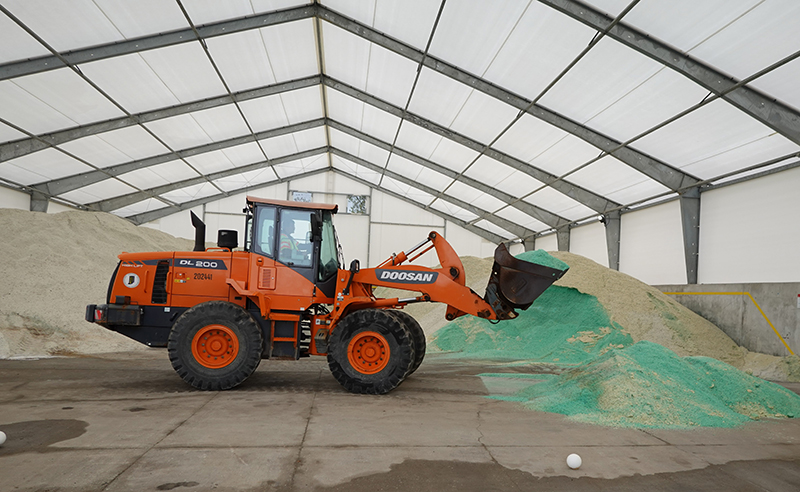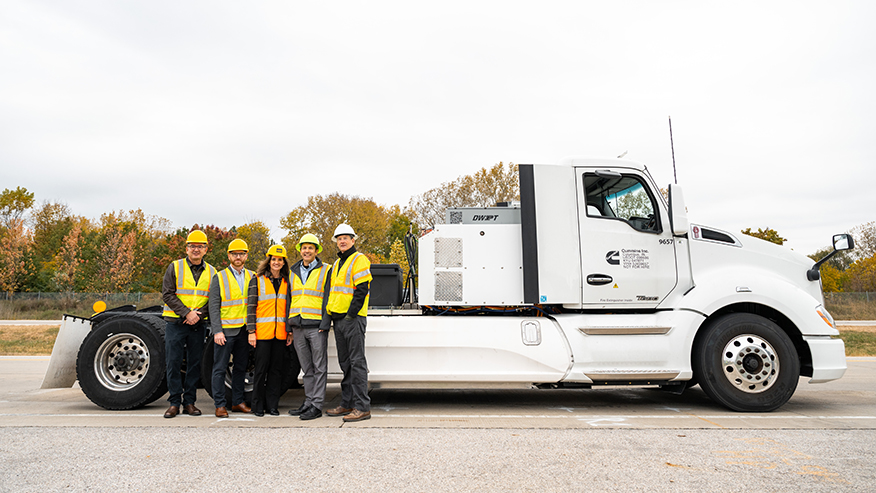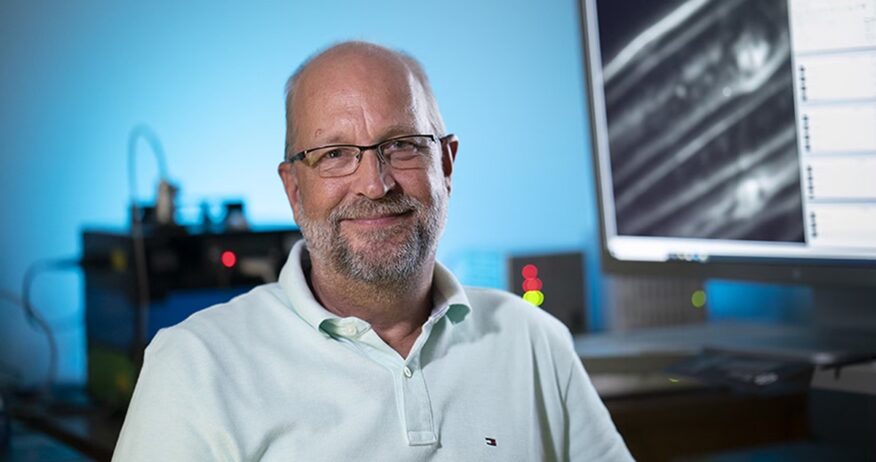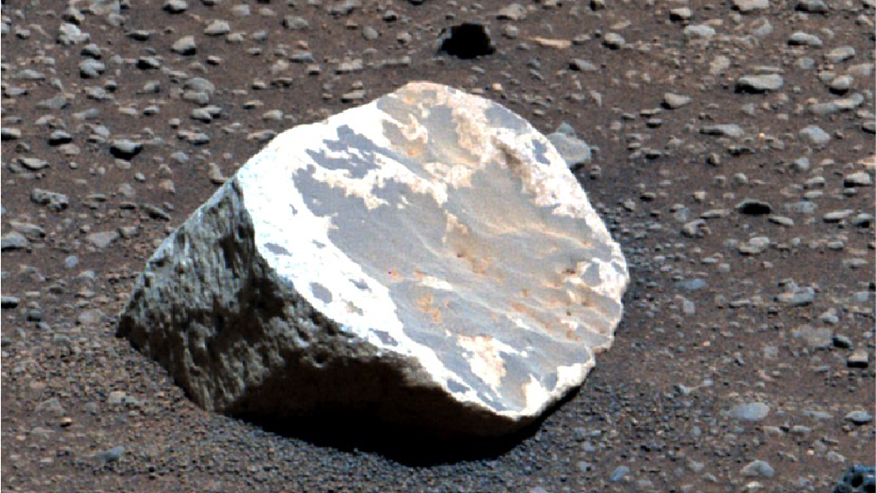Portable tech platform monitors volume of bulk material stockpiles in timely, cost-effective method
Purdue civil engineers developed SMART platform with Indiana Department of Transportation funding

A wheel loader lifts salt from stockpiles managed by the Indiana Department of Transportation. Purdue University civil engineers have created SMART, or salt monitoring and reporting technology, to measure stockpile volumes faster, safer and less expensively than traditional methods. (Purdue University photo/Darcy Bullock)
WEST LAFAYETTE, Ind. —
Purdue University civil engineers have developed a fully automated, portable system to estimate the volume of stockpiles of bulk supplies like salt and other materials used in industrial, highway and agricultural applications.
The Indiana Department of Transportation funded the research through its Joint Transportation Research Program. A paper about the innovation was published in the peer-reviewed journal Remote Sensing.
Stockpile management is important in roadway maintenance, which uses salt to deice roads to keep traffic flowing safely, and in other applications. Government agencies are increasingly interested in tracking stockpiles to assess their environmental impact, including effects on roadside vegetation and the salinity of surface water. Salt and sand also may affect pavement durability.

Jeremy McGuffey, statewide winter operations manager for INDOT, said the department has nearly 120 salt storage buildings around the state and that most locations visually estimate the volume.
“This is inherently incorrect and will vary from person to person,” McGuffey said. “If I pointed to a pile of stone on the ground, could another person accurately tell me the volume of that stone based on sight alone?
“There are a few locations that use survey equipment to take measurements based on the exterior size – the height and width – of the stockpile, but those don’t account for depth. Many of our buildings are full of salt year-round, and there is no way to reach the back side of the pile to determine how long it is.”
Traditional methods to measure stockpiles use field survey procedures that last several hours and expose surveying crews to dangerous conditions. Modern LiDAR technology – or light detection and ranging technology – is safer and more reliable, but its peak performance is confined to well-planned scanning and complex data processing schemes when dealing with large indoor sites.
Salt monitoring and reporting technology, or SMART, was created by Ayman Habib, the Thomas A. Page Professor of Civil Engineering, and Darcy Bullock, the Lyles Family Professor of Civil Engineering, both from Purdue’s Lyles School of Civil Engineering.
Habib said SMART integrates consumer-grade sensing modalities of imaging and LiDAR units to acquire stockpile data in fewer than 10 minutes per facility, even in challenging environmental situations.
“SMART also uses an innovative data-processing strategy that can handle this data for accurate evaluation of stockpile volume as well as provide a visual record of the mapped facility in the form of colorized point clouds,” Habib said.
SMART is more precise, more cost-effective and safer than traditional commercial technologies to estimate the volume of stockpiles of bulk materials.
“The technology estimates volume with less than 1% error and costs less than $10,000; existing technologies cost more than twice that,” Habib said. “It also allows for practical, quick and safe data acquisition. Some traditional technologies require an operator to climb the stockpile, which leads to extended and unsafe data acquisition.”
McGuffey said SMART has already brought positive results to INDOT.
“With the system we developed with Purdue, the empty dimensions of the building are solved for first, and then the salt pile’s volume can be easily calculated. The LiDAR system bounces light off the pile millions of times to collect the information we need to determine the volume,” McGuffey said. “The other huge plus is that this system is mostly automated with the only real human interaction being the initial install and then periodic cleaning.”
Habib and Bullock disclosed the information to the Purdue Research Foundation Office of Technology Commercialization, which has applied for a patent from the U.S. Patent and Trademark Office. For information about licensing opportunities, contact Dhananjay Sewak of OTC at dsewak@prf.org about 2021-HABI-69512.
Habib said the next steps in developing SMART are to package the system so it can be permanently mounted in a storage facility to allow for automated data collection, to strengthen its ability to work in storage facilities with domed rooftops, and to enhance the value of the data by driving colorized points.
About Purdue University
Purdue University is a top public research institution developing practical solutions to today’s toughest challenges. Ranked in each of the last four years as one of the 10 Most Innovative universities in the United States by U.S. News & World Report, Purdue delivers world-changing research and out-of-this-world discovery. Committed to hands-on and online, real-world learning, Purdue offers a transformative education to all. Committed to affordability and accessibility, Purdue has frozen tuition and most fees at 2012-13 levels, enabling more students than ever to graduate debt-free. See how Purdue never stops in the persistent pursuit of the next giant leap at https://stories.purdue.edu.
About Purdue Research Foundation Office of Technology Commercialization
The Purdue Research Foundation Office of Technology Commercialization operates one of the most comprehensive technology transfer programs among leading research universities in the U.S. Services provided by this office support the economic development initiatives of Purdue University and benefit the university’s academic activities through commercializing, licensing and protecting Purdue intellectual property. The office is housed in the Convergence Center for Innovation and Collaboration in Discovery Park District at Purdue, adjacent to the Purdue campus. In fiscal year 2021, the office reported 159 deals finalized with 236 technologies signed, 394 disclosures received and 187 issued U.S. patents. The office is managed by the Purdue Research Foundation, which received the 2019 Innovation and Economic Prosperity Universities Award for Place from the Association of Public and Land-grant Universities. In 2020, IPWatchdog Institute ranked Purdue third nationally in startup creation and in the top 20 for patents. The Purdue Research Foundation is a private, nonprofit foundation created to advance the mission of Purdue University. Contact otcip@prf.org for more information.
ABSTRACT
Image-Aided LiDAR Mapping Platform and Data Processing Strategy for Stockpile Volume Estimation
Raja Manish, Seyyed Meghdad Hasheminasab, Jidong Liu, Yerassyl Koshan, Justin Anthony Mahlberg, Yi-Chun Lin, Radhika Ravi, Tian Zhou, Jeremy McGuffey, Timothy Wells, Darcy Bullock and Ayman Habib
Stockpile quantity monitoring is vital for agencies and businesses to maintain inventory of bulk material such as salt, sand, aggregate, lime, and many other materials commonly used in agriculture, highways, and industrial applications. Traditional approaches for volumetric assessment of bulk material stockpiles, e.g., truckload counting, are inaccurate and prone to cumulative errors over long time. Modern aerial and terrestrial remote sensing platforms equipped with camera and/or light detection and ranging (LiDAR) units have been increasingly popular for conducting high-fidelity geometric measurements. Current use of these sensing technologies for stockpile volume estimation is impacted by environmental conditions such as lack of global navigation satellite system (GNSS) signals, poor lighting, and/or featureless surfaces. This study addresses these limitations through a new mapping platform denoted as Stockpile Monitoring and Reporting Technology (SMART), which is designed and integrated as a time-efficient, cost-effective stockpile monitoring solution. The novel mapping framework is realized through camera and LiDAR data-fusion that facilitates stockpile volume estimation in challenging environmental conditions. LiDAR point clouds are derived through a sequence of data collections from different scans. In order to handle the sparse nature of the collected data at a given scan, an automated image-aided LiDAR coarse registration technique is developed followed by a new segmentation approach to derive features, which are used for fine registration. The resulting 3D point cloud is subsequently used for accurate volume estimation. Field surveys were conducted on stockpiles of varying size and shape complexity. Independent assessment of stockpile volume using terrestrial laser scanners (TLS) shows that the developed framework had close to 1% relative error.
Writer: Steve Martin, sgmartin@prf.org
Sources: Ayman Habib, ahabib@purdue.edu
Jeremy McGuffey, jmcguffey@indot.in.gov



